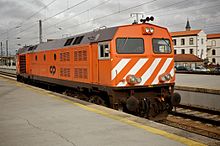
In February 2009, the government of Portugal announced plans to build a high-speed rail line from Lisbon to Madrid; this plan was cancelled in March 2012 amidst a bailout programme of financial assistance to the Portuguese Republic. The project was valued at €7.8 billion and the government had claimed it would create 100,000 jobs. The line would link to Spain's Southwest Corridor.

The South African Railways Class 7D 4-8-0 of 1915 was a steam locomotive.

The history of rail transport in Portugal dates from 28 October 1856, when Portugal's first railway line was opened between Lisbon and Carregado: the Companhia dos Caminhos de Ferro Portugueses.

The South African Railways Class NG6 4-4-0 of 1895 was an ex-Mozambican narrow-gauge steam locomotive from the Beira Railway era.

The Série 1800 were a series of 10 diesel-electric locomotives built for the Portuguese Railways (CP) in 1968. Designed and engineered by English Electric, they were closely modelled on the British Rail Class 50 locomotives but built for CP's 1,668 mmIberian gauge and larger loading gauge than possible in Great Britain.

The Série 1400 are a series of 67 diesel-electric locomotives built for the Portuguese Railways (CP) between 1967 and 1969. They have a top speed of 105 km/h.
Série 2500 were the first 15 electric locomotives built for the Portuguese Railways (CP). They entered service in 1956, for the newly electrified 25 kV line running north from Lisbon. They had a maximum speed of 120 km/h. They were withdrawn from service in 2009; all but one have been sold for scrap.
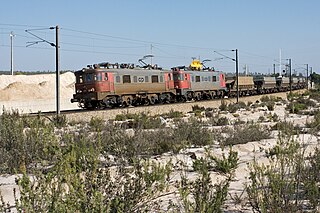
Série 2550 were the second batch of 25 kV electric locomotives built for Portuguese Railways (CP). They entered service in 1964 and were used on the main line between Lisbon and Oporto. 20 locomotives were built; as of 2012 none remain in service. Unlike the earlier Série 2500, the Série 2550 were built with unpainted stainless steel bodywork. They were constructed by Sorefame, with components from the French company Alsthom.
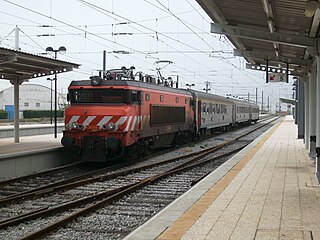
Série 2600, nicknamed Nez-Cassée("broken nose"), is a type of 25 kV 50 Hz electric locomotive formerly used by Portuguese Railways. They are closely based on the SNCF Class BB 15000 locomotive design. The locomotives were styled by Paul Arzens, designed by Groupement 50Hz and entered service in 1974. Of the 12 built, 9 were still in service in 2012. They have a top speed of 160 km/h.
Série 1150 are small Sentinel shunting locomotives built in 1966-1967 for Portuguese Railways (CP). They are based on the "Steelman" shunting locomotive used at various industrial plants arounds the UK. They have a maximum speed of 58 km/h. As of 2012, seven locomotives remain in service.
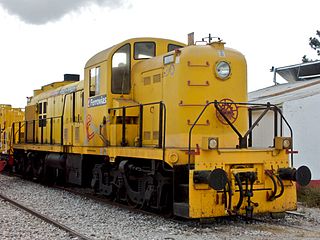
The Série 1500 of the Portuguese Railways were introduced in 1948, making them amongst the first main line diesel locomotives to be used in Europe. These 12 locomotives were built in the United States by ALCO, to the constructor's type RSC-2 specification. The locomotives were purchased with assistance from Marshall Aid funds in an attempt to cut the railway's running costs, modernise the system and help alleviate Portugal's shortage of coal following World War II.

The Série 1930 are a class of diesel-electric locomotives formerly used by Portuguese Railways (CP). They are visually very similar to the Série 1900 locomotives, but have a higher top speed of 120 km/h. They were assembled in Portugal by Sorefame, under licence from the French company Alsthom and entered service in 1981. The final locomotive in service was withdrawn following failure in October 2018.

The Tua line was a metre gauge railway line in northern Portugal, which connected Tua to Bragança. The line was opened in 1887 and closed in 2018. The section from Mirandela to Brunheda is planned to be reopened in 2019.

The Corgo line(Linha do Corgo) was a 1,000 mmmetre gauge railway line in northern Portugal. It closed in 2009. It ran north from Régua to Vila Real and Chaves. The line was latterly operated by Comboios de Portugal.

The Tâmega line(Linha do Tâmega) was a 1,000 mmmetre gauge railway line in northern Portugal. It closely followed the course of the Tâmega River. It closed in 2009.

Portugal formerly had several hundred kilometres of narrow-gauge railways, but by 2010 only two lines were still in operation – the Vouga line and the Metro de Mirandela. The lines were operated by Comboios de Portugal and maintained by REFER.
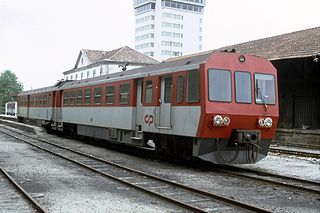
The Série 9600 are a class of diesel multiple unit train built for metre gauge lines on Portuguese Railways (CP). They entered service in 1979. They were later supplemented by the Série 9630.
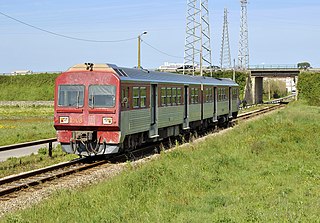
The Série 9630 are a class of diesel multiple unit trains built for the metre gauge lines of Portuguese Railways (CP) in the Porto area. The trains were built in Portugal by Sorefame and entered service in 1991.

Linha da Beira Alta is an international railway line which connects Pampilhosa on the Linha do Norte, close to Coimbra, to the border with Spain, at Vilar Formoso.
